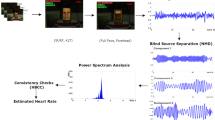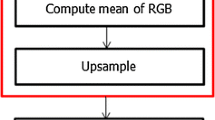Abstract
Heart rate (HR) measurement and monitoring is of great importance to determine the physiological and mental status of individuals. Recently, it has been demonstrated that HR can be remotely retrieved from facial video-based photoplethysmographic signals captured using consumer-grade cameras. However, in existing studies, subjects are mostly required to keep their facial regions of interest (ROIs) within one single camera. To make this technique usable in a daily life situation where subjects move around freely, we launch a preliminary simulated study of seamless remote HR measurement using multiple synchronized cameras by combining ensemble empirical mode decomposition (EEMD) with time-delay canonical correlation analysis (TDCCA), termed as EEMD-TDCCA. At each time point, a target ROI with the largest area is first determined from all the ROIs provided by all the cameras. Then, the RGB time sequence is formed by taking average of all pixels within each target ROI. Afterwards, the green channel time sequence is decomposed into several intrinsic mode functions (IMFs) and only the IMF candidates, whose frequency corresponding to the maximum amplitude falling into the interested HR range will be further processed by TDCCA. Finally, the first pair of the canonical variables having the largest correlation coefficient is the HR source and the corresponding HR is derived by peak detection or frequency analysis. Thirty subjects were recruited and four state-of-the-art methods were employed for comparison. The best performance was achieved by using the proposed EEMD-TDCCA followed by frequency analysis, with the mean absolute error 4.11 bpm, mean percentage error 5.26%, root mean square error 5.37 bpm, the Pearson’s correlation coefficient 0.90 and the intra-class correlation coefficient 0.89, demonstrating the feasibility of our proposed seamless remote HR measurement framework. This study will provide a promising solution for practical and robust non-contact HR measurement applications.






Similar content being viewed by others
References
Aarts LA, Jeanne V, Cleary JP, Lieber C, Nelson JS, Oetomo SB, Verkruysse W (2013) Non-contact heart rate monitoring utilizing camera photoplethysmography in the neonatal intensive care unit a pilot study. Early Hum Dev 89(12):943–948
Al-Naji A, Perera AG, Chahl J (2017) Remote monitoring of cardiorespiratory signals from a hovering unmanned aerial vehicle. Biomed Eng Online 16(1):101
Amelard R, Scharfenberger C, Kazemzadeh F, Pfisterer KJ, Lin BS, Clausi DA, Wong A (2015) Feasibility of long-distance heart rate monitoring using transmittance photoplethysmographic imaging (ppgi). Sci Rep 5:14637
Blackford EB, Estepp JR (2017) Using consumer-grade devices for multi-imager non-contact imaging photoplethysmography. In: Optical Diagnostics and Sensing XVII: Toward Point-of-Care Diagnostics, vol. 10072. International Society for Optics and Photonics, pp 100720P
Caruccio L, Polese G, Tortora G, Iannone D (2019) Edcar: a knowledge representation framework to enhance automatic video surveillance. Expert Syst Appl 131:190–207
Chen X, Wang ZJ, McKeown M (2013) A three-step multimodal analysis framework for modeling corticomuscular activity with application to parkinson’s disease. IEEE J Biomed Health Inf 18(4):1232–1241
Chen X, Liu A, Peng H, Ward R (2014) A preliminary study of muscular artifact cancellation in single-channel eeg. Sensors 14(10):18 370–18 389
Chen D-Y, Wang J-J, Lin K-Y, Chang H-H, Wu H-K, Chen Y-S, Lee S-Y (2015) Image sensor-based heart rate evaluation from face reflectance using hilbert–huang transform. IEEE Sens J 15(1):618–627
Chen X, Liu A, Chiang J, Wang ZJ, McKeown M, Ward RK (2015) Removing muscle artifacts from eeg data: Multichannel or single-channel techniques? IEEE Sens J 16(7):1986–1997
Chen X, Wang ZJ, McKeown M (2016) Joint blind source separation for neurophysiological data analysis: Multiset and multimodal methods. IEEE Signal Proc Mag 33(3):86–107
Chen X, Chen Q, Zhang Y, Wang ZJ (2018) A novel eemd-cca approach to removing muscle artifacts for pervasive eeg. IEEE Sens J 19(19):8420–8431
Chen X, Cheng J, Song R, Liu Y, Ward R, Wang ZJ (2018) Video-based heart rate measurement: Recent advances and future prospects. IEEE Transactions on Instrumentation and Measurement
Chen X., Xu X., Liu A., McKeown M. J., Wang Z. J. (2018) The use of multivariate emd and cca for denoising muscle artifacts from few-channel EEG recordings. IEEE Trans Instrum Measur 67(2):359–370
Cheng J, Chen X, Xu L, Wang ZJ (2017) Illumination variation-resistant video-based heart rate measurement using joint blind source separation and ensemble empirical mode decomposition. IEEE J Biomed Health Inf 21(5):1422–1433
Correa NM, Adali T, Li Y-O, Calhoun VD (2010) Canonical correlation analysis for data fusion and group inferences. IEEE Signal Process Mag 27(4):39–50
De Haan G, Jeanne V (2013) Robust pulse rate from chrominance-based rppg. IEEE Trans Biomed Eng 60(10):2878–2886
Estepp JR, Blackford EB, Meier CM (2014) Recovering pulse rate during motion artifact with a multi-imager array for non-contact imaging photoplethysmography. In: 2014 IEEE International Conference on Systems, Man, and Cybernetics (SMC). IEEE, pp 1462–1469
Feng L, Po L-M, Xu X, Li Y, Ma R (2015) Motion-resistant remote imaging photoplethysmography based on the optical properties of skin. IEEE Trans Circ Syst Video Technol 25(5):879–891
Guo Z, Wang ZJ, Shen Z (2014) Physiological parameter monitoring of drivers based on video data and independent vector analysis. In: 2014 IEEE International Conference on Acoustics, Speech and Signal Processing (ICASSP). IEEE, pp 4374–4378
Haque MA, Irani R, Nasrollahi K, Moeslund TB (2016) Heartbeat rate measurement from facial video. IEEE Intell Syst 31(3):40–48
Hassan M, Malik A, Fofi D, Saad N, Meriaudeau F (2017) Novel health monitoring method using an rgb camera. Biomed Opt Express 8(11):4838–4854
Hills M (1987) The design and analysis of clinical experiments. J R Stat Soc Ser A (Gen) 150(4):400–400
Holton BD, Mannapperuma K, Lesniewski PJ, Thomas JC (2013) Signal recovery in imaging photoplethysmography. Physiol Measur 34(11):1499
Hotelling H (1935) Relations between 2 sets of variants. Biometrika 28(3–4):312–377
Huang NE, Shen Z, Long SR, Wu MC, Shih HH, Zheng Q, Yen N-C, Tung CC, Liu H (1998) The empirical mode decomposition and the hilbert spectrum for nonlinear and non-stationary time series analysis. Proc R Soc Lond Ser A: Math Phys Eng Sci 454(1971):903–995
Kalal Z, Mikolajczyk K, Matas J (2012) Tracking-learning-detection. IEEE Trans Pattern Anal Mach Intell 34(7):1409–1422
Lee D, Kim J, Kwon S, Park K (2015) Heart rate estimation from facial photoplethysmography during dynamic illuminance changes. In: 2015 37th Annual International Conference of the IEEE Engineering in Medicine and Biology Society (EMBC). IEEE, pp 2758–2761
Leonhardt S, Leicht L, Teichmann D (2018) Unobtrusive vital sign monitoring in automotive environments a review. Sensors 18(9):3080
Lewandowska M, Rumiński J, Kocejko T, Nowak J (2011) Measuring pulse rate with a webcam a non-contact method for evaluating cardiac activity. In: 2011 federated conference on computer science and information systems (FedCSIS). IEEE, pp 405–410
Li X, Chen J, Zhao G, Pietikainen M (2014) Remote heart rate measurement from face videos under realistic situations. In: Proceedings of the IEEE conference on computer vision and pattern recognition, pp 4264–4271
Liu H, Sun X (2016) Linear canonical correlation analysis based ranking approach for facial age estimation. In: 2016 IEEE International Conference on Image Processing (ICIP). IEEE, pp 3249–3253
McDuff DJ, Blackford EB, Estepp JR (2018) Fusing partial camera signals for noncontact pulse rate variability measurement. IEEE Trans Biomed Eng 65(8):1725–1739
Monkaresi H, Calvo RA, Yan H (2014) A machine learning approach to improve contactless heart rate monitoring using a webcam. IEEE J Biomed Health Inf 18(4):1153–1160
Po L-M, Feng L, Li Y, Xu X, Cheung TC-H, Cheung K-W (2018) Block-based adaptive roi for remote photoplethysmography. Multimed Tools Appl 77 (6):6503–6529
Poh M-Z, McDuff DJ, Picard RW (2010) Non-contact, automated cardiac pulse measurements using video imaging and blind source separation. Opt Express 18 (10):10 762–10 774
Poh M-Z, McDuff DJ, Picard RW (2011) Advancements in noncontact, multiparameter physiological measurements using a webcam. IEEE Trans Biomed Eng 58(1):7–11
Qi H, Guo Z, Chen X, Shen Z, Wang ZJ (2017) Video-based human heart rate measurement using joint blind source separation. Biomed Signal Process Control 31:309–320
Rasche S, Trumpp A, Waldow T, Gaetjen F, Plötze K, Wedekind D, Schmidt M, Malberg H, Matschke K, Zaunseder S (2016) Camera-based photoplethysmography in critical care patients. Clin Hemorheol Microcirc 64(1):77–90
Rouast PV, Adam MT, Chiong R, Cornforth D, Lux E (2018) Remote heart rate measurement using low-cost rgb face video: a technical literature review. Front Comput Sci 12(5):858–872
Soneson C, Lilljebjörn H, Fioretos T, Fontes M (2010) Integrative analysis of gene expression and copy number alterations using canonical correlation analysis. BMC Bioinform 11(1):191
Sun Y, Azorin-Peris V, Kalawsky R, Hu S, Papin C, Greenwald SE (2012) Use of ambient light in remote photoplethysmographic systems: comparison between a high-performance camera and a low-cost webcam. J Biomed Opt 17(3):037005
Sun Y, Thakor N (2016) Photoplethysmography revisited: from contact to noncontact, from point to imaging. IEEE Trans Biomed Eng 63(3):463–477
Tarassenko L, Villarroel M, Guazzi A, Jorge J, Clifton D, Pugh C (2014) Non-contact video-based vital sign monitoring using ambient light and auto-regressive models. Physiol Measur 35(5):807
Tarvainen MP, Ranta-Aho PO, Karjalainen PA (2002) An advanced detrending method with application to hrv analysis. IEEE Trans Biomed Eng 49(2):172–175
Verkruysse W, Svaasand LO, Nelson JS (2008) Remote plethysmographic imaging using ambient light. Opt Express 16(26):21 434–21 445
Wang W, Stuijk S, De Haan G (2016) A novel algorithm for remote photoplethysmography: Spatial subspace rotation. IEEE Trans Biomed Eng 63 (9):1974–1984
Wang W, den Brinker AC, Stuijk S, de Haan G (2017) Algorithmic principles of remote ppg. IEEE Trans Biomed Eng 64(7):1479–1491
Wu Z, Huang NE (2009) Ensemble empirical mode decomposition: a noise-assisted data analysis method. Adv Adapt Data Anal 1(01):1–41
Xu L, Cheng J, Chen X (2017) Illumination variation interference suppression in remote ppg using pls and memd. Electron Lett 53(4):216–218
Yang Z, Yang X, Wu X (2019) Motion-tolerant heart rate estimation from face videos using derivative filter. Multimed Tools Appl 78:26747–26757
Yu S, Hu S, Azorin-Peris V, Chambers JA, Zhu Y, Greenwald SE (2011) Motion-compensated noncontact imaging photoplethysmography to monitor cardiorespiratory status during exercise. J Biomed Opt 16(7):077010
Yu Y-P, Raveendran P, Lim C-L, Kwan B-H (2015) Dynamic heart rate estimation using principal component analysis. Biomed Opt Express 6(11):4610–4618
Zhao F, Li M, Jiang Z, Tsien JZ, Lu Z (2016) Camera-based, non-contact, vital-signs monitoring technology may provide a way for the early prevention of sids in infants. Front Neurol 7:236
Zheng S, Sturgess P, Torr PH (2013) Approximate structured output learning for constrained local models with application to real-time facial feature detection and tracking on low-power devices. In: 2013 10th IEEE International Conference and Workshops on Automatic Face and Gesture Recognition (FG). IEEE, pp 1–8
Acknowledgments
This work was supported by the National Key R&D Program of China (Grant 2017YFB1002802), National Natural Science Foundation of China (Grants: 61922075, 81571760, 61701160 and 41901350) and the Fundamental Research Funds for the Central Universities (Grants: JZ2019HGBZ0151 and JZ2020HGPA0111).
Author information
Authors and Affiliations
Corresponding author
Additional information
Publisher’s note
Springer Nature remains neutral with regard to jurisdictional claims in published maps and institutional affiliations.
Rights and permissions
About this article
Cite this article
Cheng, J., Wang, X., Song, R. et al. Exploring the feasibility of seamless remote heart rate measurement using multiple synchronized cameras. Multimed Tools Appl 79, 23023–23043 (2020). https://doi.org/10.1007/s11042-020-09075-2
Received:
Revised:
Accepted:
Published:
Issue Date:
DOI: https://doi.org/10.1007/s11042-020-09075-2




